UPPER HARDRES CHURCH

Brasses in Upper Hardres
| Home |
| Welcome |
| Joining in |
| Services |
| Children |
| Choir |
| History |
| Brasses |
| Contacts |
| Location |
| Links |
| Parish |
Upper Hardres church has retained a number of monumental brasses, mainly to the Hardres family and located in the Lady Chapel.
The
oldest brass in the church is that of John
Strete, Rector of the
parish, who died in
1405. It is unusual not
just because it is rare,
but because it is the
only complete example in
Great Britain where the
deceased kneels in front
of a saint. The
inscription on the
scroll reads: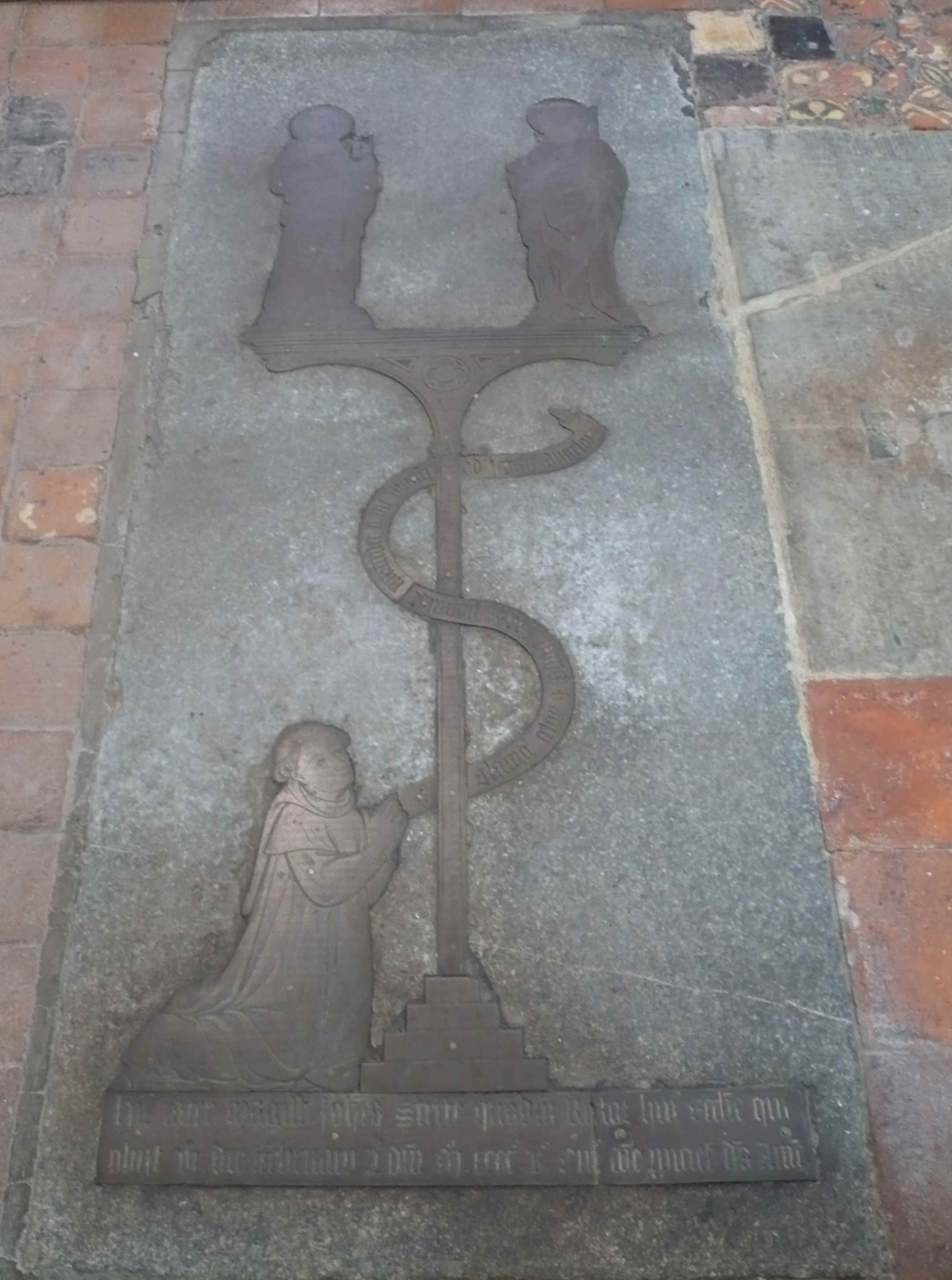
Clavig' celor' et Paul doctor populor interceder p me dignei ad regem angelor
("O key bearer of Heaven and Paul the teacher of the nations, deign to intercede for me to the King of the Angels")
The inscription at the foot of the brass reads:
Hie jacet Magist' Johes Strete quodm Rector hui ecclic qui obiit vi die Februarii A dni Mccccv, cui' aie ppiciet' d's Ame.
("Here lies Master John Strete, formerly Rector of this Church, who died February 6th, A.D. 1405, on whose soul may God have mercy. Amen.")
In the south chapel, the oldest brass belongs to George Hardres. George was the son of Philip Hardres (temp. Henry III.) and his wife Grace, daughter and co heiress of Stephen Heringod of Elmstead. He was the grandfather of Christopher Hardres who married Dorothy, daughter of Sir John Paston. This was the Norfolk family famous for the 'Paston Letters'.
Dorothy Hardres
died in 1533, and is commemorated
by a brass
still existing in the
chapel. It consists of a
coat of arms and the
following description: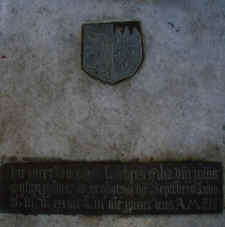
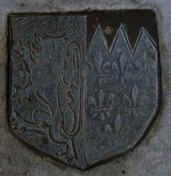 Hic jacet Dorothea
Hardres, Filia dmi Johis
Paston Militis. Que
obitt III die Septebris
Anno do McVcXXXIII. Cui
aie ppiciet deus. Amen
Hic jacet Dorothea
Hardres, Filia dmi Johis
Paston Militis. Que
obitt III die Septebris
Anno do McVcXXXIII. Cui
aie ppiciet deus. Amen
Here lies Dorothy Hardres, daughter of Sir John Paston, Knight who died September 3rd, A.D. 1533. On whose soul may God have mercy. Amen.
The coat of arms bears a lion rampant (Hardres) impaling six fleurs de lis, 3, 2, 1, a chief dauncetté (Paston).
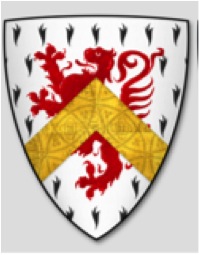
Arms of Hardres
The Dering Roll of
Arms produced during the
reign of Edward I. gives
the arms of Hardres as:
"Ermine, a lion rampant gules, debrused by a
chevron or".
These are shown on the far
left.

The chevron was derived from the coat of De Clare, Earl of Gloucester from 1180 to 1314 (when the last Earl was killed at Bannockburn), under whom the Hardres family originally held the Manor.
Arms of de Clare
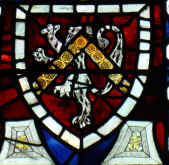 The later version of the Hardres coat of arms can
be seen on the stone
monument to Sir Thomas
Hardres A.D.1688, on
the floor of the Lady
Chapel. None of the
Hardres brasses display
it, nor does it occur on
the coat of arms of
Thomas Hardres (1688) in
the monument on the
floor of the chancel. It
is best seen in the East
window of the church.
The Hardres arms also appear in
a panel of the eastern
transept window of
Canterbury Cathedral.
The later version of the Hardres coat of arms can
be seen on the stone
monument to Sir Thomas
Hardres A.D.1688, on
the floor of the Lady
Chapel. None of the
Hardres brasses display
it, nor does it occur on
the coat of arms of
Thomas Hardres (1688) in
the monument on the
floor of the chancel. It
is best seen in the East
window of the church.
The Hardres arms also appear in
a panel of the eastern
transept window of
Canterbury Cathedral.
Arms of Hardres in the church east window
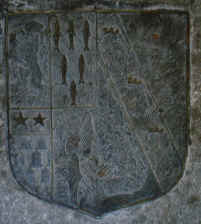 Next
to the brass of Dorothy
Hardres is one in the
memory of Mabell, wife
of Richard Hardres, who
was the son of
Christopher and Dorothy
Hardres. It now consists
of two shields of arms
and an inscription, but
there is no doubt there
were formerly four
shields of arms, the
matrices of the missing
shields being now
underneath the arch
leading to the chapel.
Part of one of those
shields was discovered a
few years ago at Hardres
Court, and is identical
with the two still in
position. The arms are
the same on each, viz. :
Quarterly: (1) Gules, a
lion rampant ermine
[Hardres] ; (2) Six
herrings haurient, 3, 2,
1 [Heringold]; (3) Vair,
on a chief gules, two
mullets of five points
or [Fitzbarnard]; (4)
Gules, three lucies
haurient argent [Lucy], impaling
Argent, on a bend sable,
three lions' heads
erased of the field,
crowned or [Wroth of
Bledenhall]. The
inscription reads:
Next
to the brass of Dorothy
Hardres is one in the
memory of Mabell, wife
of Richard Hardres, who
was the son of
Christopher and Dorothy
Hardres. It now consists
of two shields of arms
and an inscription, but
there is no doubt there
were formerly four
shields of arms, the
matrices of the missing
shields being now
underneath the arch
leading to the chapel.
Part of one of those
shields was discovered a
few years ago at Hardres
Court, and is identical
with the two still in
position. The arms are
the same on each, viz. :
Quarterly: (1) Gules, a
lion rampant ermine
[Hardres] ; (2) Six
herrings haurient, 3, 2,
1 [Heringold]; (3) Vair,
on a chief gules, two
mullets of five points
or [Fitzbarnard]; (4)
Gules, three lucies
haurient argent [Lucy], impaling
Argent, on a bend sable,
three lions' heads
erased of the field,
crowned or [Wroth of
Bledenhall]. The
inscription reads:
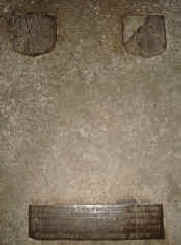
"Here lyeth buryed the bodye of Mabell Hardres, Daughter unto Sr Thomas Wrathe, Knight, the late wife of Rychard Hardres, Esquier, who deceased this present lyfe the VIII daye of Auguste, in the yere of our Lord God MCCCCCLXXIX.'Thomas & Thomas, Roger, John and Peter, Marye et Jane."
Richard Hardres died in 1612 and was succeeded by his son, Sir Thomas Hardres, who married Elanor Thoresby and who died in 1628. There is a brass inscription to the memory of his younger sons, Thomas and John, on a stone on the floor at the East end of the chapel. The matrices of the figures of two children are still visible, though the brasses have now disappeared. Hasted says the figures were in existence in his time ("History of Kent," vol. iii, p. 734, ed 1790). The inscription reads:
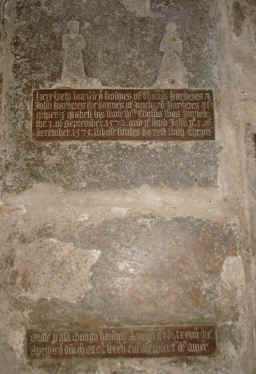
"Here lyeth buried ye bodyes of Thoms Harderes and John Harderes the sonnes of Rychard Harderes Esquyer and Maybell his Wyfe. Wch Thoms was buried the 3. September 1572 and ye sayd John ye 5. of december 1575. Whose soules do rest with Chryst."
Besides
the above, an
interesting fragment,
probably originally in
the chancel, and was
taken up at a
restoration of the
Church at the end of the
eighteenth century. Most
of the monuments seem to
have been laid down in
the memory of members of
the Hardres family, and
there is little doubt
that the recently
discovered brass
represents a member of
that ancient family. 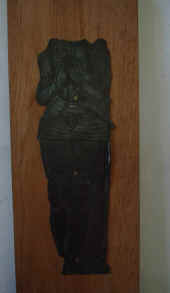 The
figure is that of a man
in amour of the time of
Edward VI or Mary I.
Unfortunately the head
is missing and the brass
is broken in half. A
curious feature of the
brass is the 'brayette',
which is rarely
represented in English
brasses. The absence of
tuiles, or pieces of
plate armour protecting
the upper part of the
leg, is also most
unusual in brasses of
this period, and makes
this example unique
among the brasses of
Kent. It seems to have
disappeared before
Hasted made his
"History of
Kent" (1790), as he
makes no mention of it.
This brass has now been
mounted and hangs on the
South wall of the Lady
Chapel.
The
figure is that of a man
in amour of the time of
Edward VI or Mary I.
Unfortunately the head
is missing and the brass
is broken in half. A
curious feature of the
brass is the 'brayette',
which is rarely
represented in English
brasses. The absence of
tuiles, or pieces of
plate armour protecting
the upper part of the
leg, is also most
unusual in brasses of
this period, and makes
this example unique
among the brasses of
Kent. It seems to have
disappeared before
Hasted made his
"History of
Kent" (1790), as he
makes no mention of it.
This brass has now been
mounted and hangs on the
South wall of the Lady
Chapel.
There is an almost identical "brass" in Cobham Church, Surrey, with brayette and no tuiles. The name and date are unknown, but the authorities place it circa 1550 A.D.
Palimpsest brasses
Some of the brasses at Upper Hardres show evidence of being palimpsests (the back of an older brass having been engraved for the more recent memorial). Impressions taken from the reverse of the inscription plate and shields for Mabell Hardres indicate they were taken from a larger and earlier brass the rest of which is now lost.
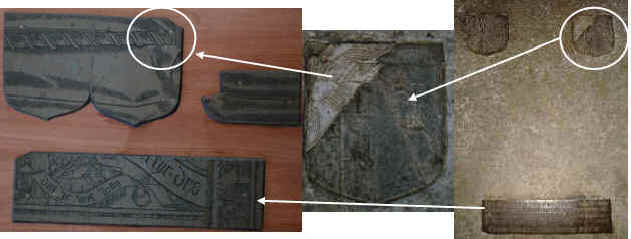
Impressions of the brasses to Mabell Hardres, indicating the impression on the rear of right hand brass shield.